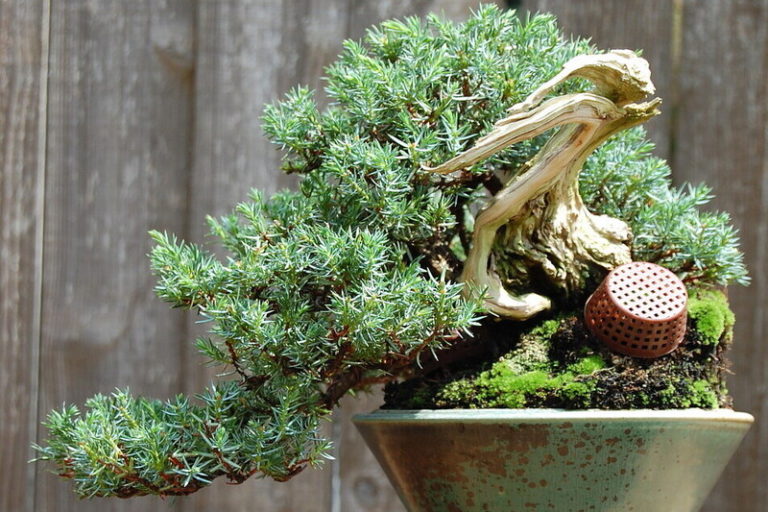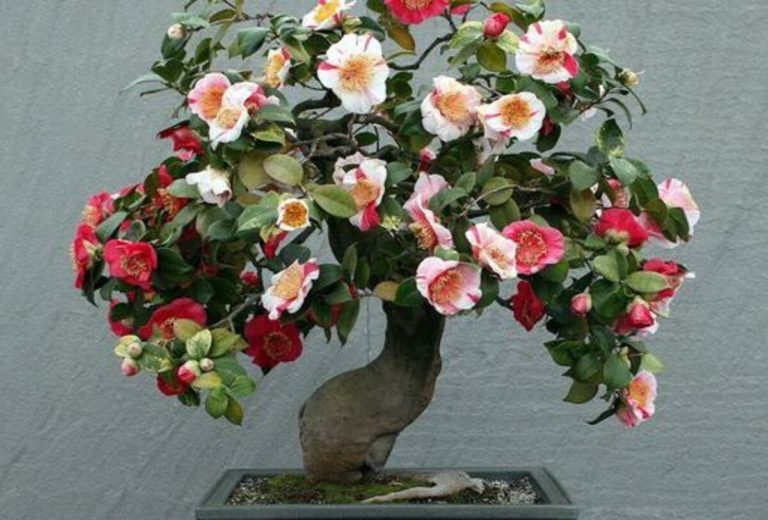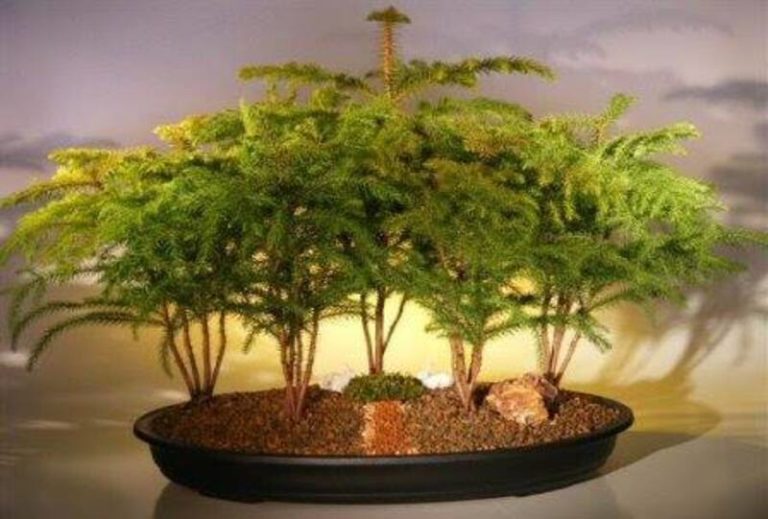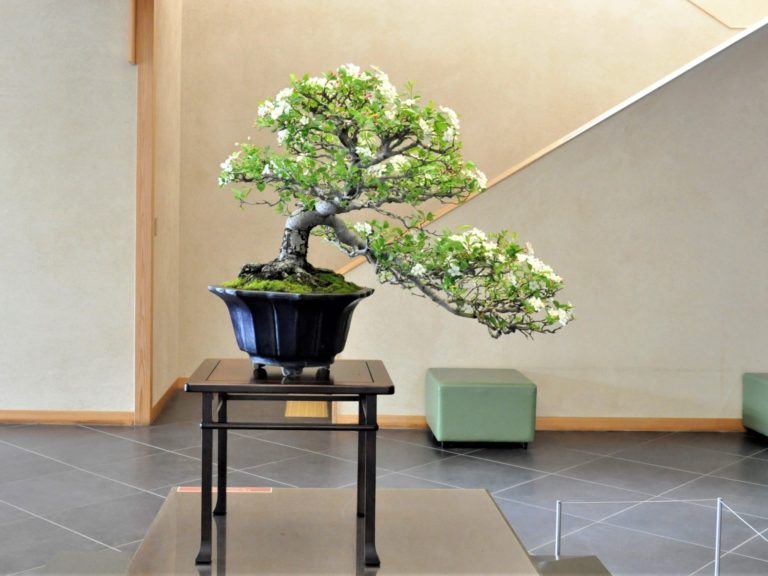Mulberry Bonsai: A Tiny Tree with Big Character
Have you ever witnessed the beautiful miniature trees that people cultivate in pots? One of the most attractive trees that can be grown in this manner is the Mulberry Bonsai. In this article, we will use straightforward, easy-to-understand language to guide you through the process of creating and caring for your very own Mulberry Bonsai.
What is Mulberry Bonsai?
Mulberry Bonsai is the art of growing miniature mulberry trees in tiny containers using pruning and training techniques to create compact and aesthetically pleasing versions of these trees. It is a combination of horticulture and art that enables the beauty of mulberry trees to be appreciated on a more intimate scale.
History and Origins of the Mulberry Bonsai
The history and origins of the Mulberry Bonsai can be traced back to the bonsai tradition, which has profound roots in Chinese and Japanese culture.
- Chinese Roots: Bonsai as an art form originated in China, where it was referred to as “penjing.” Han Dynasty (206 BC–220 AD) Chinese were the first to cultivate and shape diminutive trees for ornamental purposes. These early practices involved container-grown dwarf trees.
- Japanese Influence: Bonsai was introduced to Japan around the sixth century, and it eventually took on a uniquely Japanese flavor. Japanese bonsai artists refined and expanded cultivation and shaping techniques for miniature trees.
- Mulberry in Bonsai: Mulberry trees were likely first utilized in bonsai in Japan, where they became a favored species due to their distinctive leaves and aesthetic allure. It is not well documented when Mulberry Bonsai was first developed historically. Nonetheless, Mulberry trees, along with numerous other tree species, have been cultivated as bonsai in Japan for centuries.
- Cultural Significance: As silkworms feed on mulberry leaves, the Mulberry tree is associated with Japanese silk production traditions. The Mulberry tree’s use in bonsai may have originated from its cultural significance, attractive foliage, and artistic potential.
Today, the art of Mulberry Bonsai has spread outside of Japan and can be found all over the globe. Enthusiasts and artists continue to refine and innovate the techniques for growing and decorating Mulberry Bonsai, making it a treasured and cherished aspect of the larger bonsai tradition. The art of Mulberry Bonsai reflects the historical and cultural significance of bonsai as a whole, emphasizing reverence for nature and the desire to create living, miniature artistic expressions.
Mulberry Bonsai and Their Symbolism
Mulberry Bonsai, like many other varieties of bonsai, can bear a variety of symbolic meanings and significance. According to cultural and individual interpretations, these meanings can vary. Here are some common symbolic connotations associated with Mulberry Bonsai:
1. Resilience and Endurance: In its natural habitat, the Mulberry tree is renowned for its adaptability to numerous environmental conditions. This resilience is commonly associated with perseverance and the capacity to surmount adversity. A Mulberry Bonsai can represent resiliency in the face of adversity and the tenacity to persevere and prosper despite obstacles.
2. Patience and Perseverance: A Mulberry Bonsai requires patience and time to cultivate and shape. It is a multi-year process that requires meticulous attention and consistent effort. This reflects the concept of fortitude and perseverance in everyday life. A Mulberry Bonsai can serve as a reminder of the rewards that come with patience and steady, gradual progress toward one’s objectives.
3. Harmony with Nature: In general, bonsai represents a harmonious connection with nature. The discipline of cultivating a Mulberry Bonsai demonstrates an appreciation for the natural world and a desire to bring the beauty of nature into one’s home. It represents a relationship with the environment and the significance of preserving it.
4. Longevity and Prosperity: Some cultures have associated the Mulberry tree with longevity and prosperity. As a bonsai, it can be interpreted as a symbol of a long, bountiful life and the desire for abundance and prosperity.
5. Silk Production and Tradition: As silkworms feed on Mulberry foliage, Mulberry trees are historically significant in the production of silk in certain regions, especially Asia. A Mulberry Bonsai can represent traditional craftsmanship, the significance of industry and commerce, and the value of preserving cultural practices.
6. Artistic Expression: Bonsai in general, and Mulberry Bonsai specifically, is an artistic expression. It represents the human desire to create art and beauty from the natural world. It fosters inventiveness and aesthetic appreciation.
7. Personal Growth and Transformation: Some people perceive their Mulberry Bonsai as a reflection of their own personal growth and transformation. The process of caring for and shaping the tree reflects the individual’s own voyage, with each pruning and shaping representing personal growth and change.
It is important to observe that the symbolism of Mulberry Bonsai, like that of all bonsai, is highly personal and can vary from person to person. The diverse and multifaceted nature of this art form is highlighted by the fact that the meanings attributed to these diminutive trees frequently stem from cultural and personal perspectives.
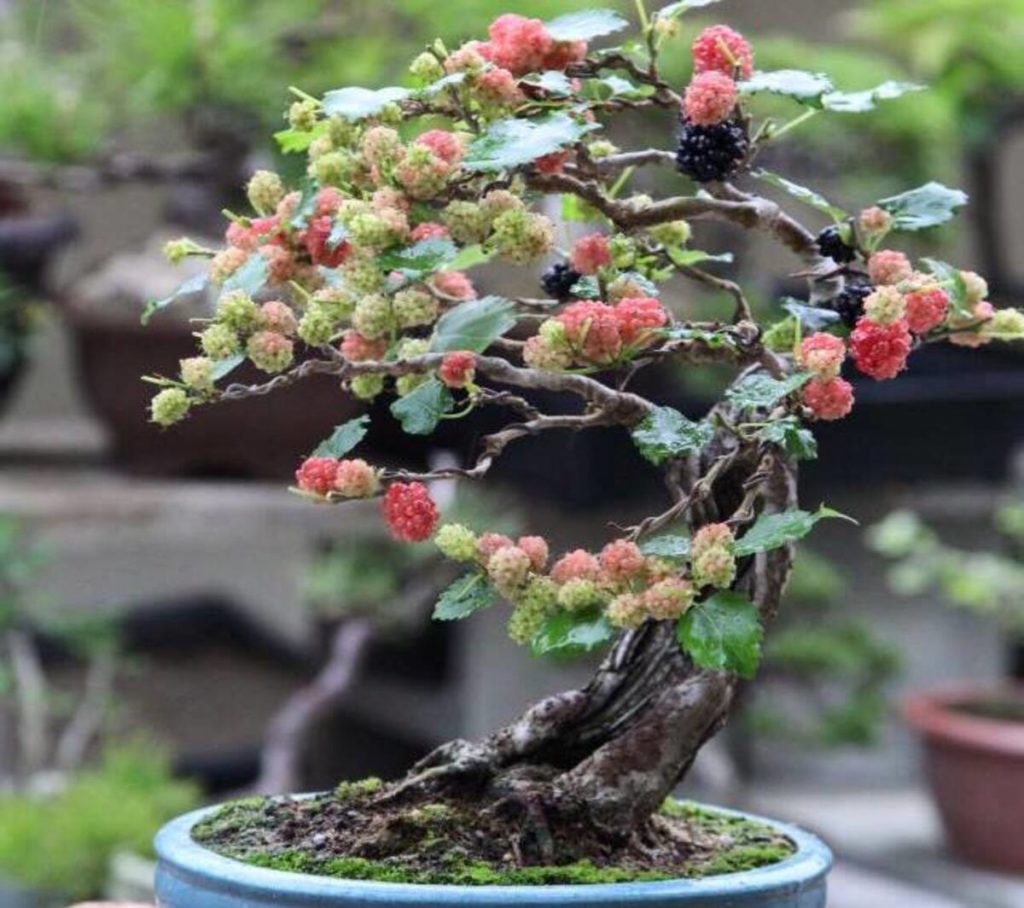
Characteristics of the Mulberry Bonsai
Like all bonsai trees, Mulberry Bonsai has special features that make it stand out as a tiny version of the real mulberry tree. Here are some of the most important things about Mulberry Bonsai:
Size: A Mulberry Bonsai’s small size is the first thing that stands out. These bonsai trees are carefully grown to stay small. They usually only grow a few inches to a few feet tall, which makes them perfect for putting on show inside.
Foliage: One thing that makes the Mulberry Bonsai stand out is its leaves. They often have lobes and a heart-shaped shape. The leaves can be different sizes based on the type of mulberry used, and they often change color with the seasons, which makes the tree more interesting to look at.
Trunk and Bark: The roots of mulberry bonsai trees can have interesting features, like bark that looks rough or is gnarled. The trunk is generally thick and proportional to the tree’s overall size, which makes it look better.
Branch Structure: A Mulberry Bonsai’s stems are carefully cut back and shaped to give it a beautiful, well-balanced look. The branch structure and layout will depend on the style, such as informal upright, windswept, or cascading.
Fruit: Some Mulberry Bonsai trees may grow tiny mulberries, which makes them look even cuter. These tiny fruits can be scaled up or down to fit the size of the tree, and people like them because they look like real mulberry trees.
Root System: A Mulberry Bonsai that is well taken care of will have roots that are strong but not too big. Roots are often cut back and repositioned to keep the tree stable and improve its look.
Seasonal Changes: Mulberry bonsai can change with the seasons, just like real mulberry plants. In the fall, the leaves may change color. In the spring, the tree may get new leaves and grow.
Artistic Styles: Mulberry bonsai can be made in a number of different artistic ways, and the style is an important part of the plant. There are many styles, such as the casual upright style, the windswept style, and the flowing style.
Aesthetic Appeal: The way a Mulberry Bonsai looks is one of the most important things about it. These bonsai trees are carefully made to look like their full-sized versions in terms of beauty and grace. This makes them interesting to look at.
Aging and Maturity: When given the right care and attention, a Mulberry Bonsai will show signs of growing old and fully grown, like fine branches, complex ramification, and a real, worn-out look.
The characteristics of a Mulberry Bonsai are its small size, distinctive foliage, meticulously crafted trunk and branches, potential fruit production, controlled root system, and the ability to be stylized in a variety of artistic forms. These characteristics contribute to Mulberry Bonsai’s aesthetic and aesthetic appeal as a living work of art.
How to Grow Mulberry Bonsai?
Growing a Mulberry Bonsai can be a rewarding and artistic endeavor, but it requires patience, dedication, and careful attention to detail. Here’s a step-by-step guide on how to grow a Mulberry Bonsai:
1. Select the Right Mulberry Species:
- Choose a Mulberry species that is suitable for bonsai cultivation. The Morus alba (white mulberry) and Morus nigra (black mulberry) are commonly used for Mulberry Bonsai.
2. Choose the Right Container:
- Select a suitable bonsai pot or container. It should have good drainage holes to prevent waterlogging. The size of the pot should be appropriate for the size of your tree.
3. Choose the Right Soil:
- Use a well-draining bonsai soil mix. A mix of akadama, pumice, and lava rock works well. This type of soil allows for good aeration and drainage.
4. Propagation:
- You can start your Mulberry Bonsai from seeds, cuttings, or by air layering. Growing from seeds is the most time-consuming method, while air layering and cuttings offer quicker results.
5. Initial Pruning and Training:
- Begin pruning your young Mulberry Bonsai to shape its trunk and branches. Use sharp pruning shears to carefully trim away excess growth, but avoid removing too much at once. Start with basic shaping and wiring as needed.
6. Repotting:
- As your bonsai grows, you’ll need to repot it every couple of years. Repotting helps refresh the soil and encourages healthy root growth. Do this during the spring or early summer.
7. Regular Pruning and Shaping:
- Regularly prune your Mulberry Bonsai to maintain its shape and size. Pay attention to the development of branches and foliage pads. Wiring can be used to guide the branches into their desired positions.
8. Watering:
- Maintain consistent moisture levels. Water your Mulberry Bonsai when the soil surface starts to dry. Avoid overwatering, as this can lead to root rot. Make sure the pot has proper drainage.
9. Sunlight and Temperature:
- Place your Mulberry Bonsai in a location that receives plenty of indirect sunlight. These trees thrive in full to partial sun. Protect your bonsai from extreme temperatures and frost, especially during the winter.
10. Fertilizing:
- Use a balanced, water-soluble fertilizer during the growing season (spring to early autumn). Fertilize your bonsai every 2–4 weeks. Reduce or stop fertilization during the dormant winter period.
11. Pest and Disease Management:
- Regularly inspect your Mulberry Bonsai for pests and diseases. Common issues may include aphids, scale insects, or fungal diseases. Address any problems promptly, using appropriate treatments.
12. Styling and Design:
- Choose a bonsai style that suits your vision. Mulberry Bonsai can be styled in various ways, such as formal upright, informal upright, slanting, cascading, and windswept styles. Regular pruning and wiring are essential to achieving your desired design.
13. Patience and Care:
- Bonsai is an art of patience. Growing a Mulberry Bonsai may take years to achieve the desired appearance. Continue to care for your tree with dedication and attention to detail.
Growing a Mulberry Bonsai is a rewarding and creative journey. As you care for your tree, you’ll witness its transformation into a beautiful miniature version of a full-sized mulberry tree, and you’ll appreciate the art and beauty of bonsai.
Displaying and Showcasing the Mulberry Bonsai
Displaying and exhibiting your Mulberry Bonsai is an essential part of the bonsai hobby. Here are some suggestions for displaying and presenting your Mulberry Bonsai effectively:
1. Choose an Appropriate Display Location: Choose a location that provides the correct quantity of light for your Mulberry Bonsai. The majority of bonsai, including the Mulberry Bonsai, require indirect, intense sunlight. South or east-facing windows are frequently the best option.
2. Use a Display Stand or Table: Elevate your bonsai on an appropriate display table or pedestal. This not only increases its visibility but also contributes to the presentation’s overall aesthetic. Ensure that the stand complements the bonsai’s design and size.
3. Consider a Rotating Stand: Consider using a rotating display stand so that viewers can appreciate your Mulberry Bonsai from every angle. This allows you to display the tree’s front, rear, and sides.
4. Companion Plants and Decorations: Enhance the overall appearance of the display by adding companion plants, pebbles, or decorative elements. These can complement your Mulberry Bonsai and create a scene that is more natural or harmonious.
5. Seasonal Variations: Change the display’s background to reflect the changing seasons. For instance, you can use seasonal flowers, miniature figurines, or seasonally appropriate decorations. This adds to the display’s appeal and maintains it current.
6. Bonsai Pots and Containers: The selection of bonsai planter or container can have a substantial effect on the overall presentation. Choose a container that complements the aesthetic of your Mulberry Bonsai and enhances its visual allure. The container should not compete with the tree itself.
7. Group Displays: Consider constructing group displays with multiple bonsai (called “forest plantings” or “yose-ue”). This can be an engaging method to illustrate the harmony and contrast between various tree species.
8. Outdoor Displays: If you have outdoor space, you can create an outdoor display area for your Mulberry Bonsai when weather conditions are favorable. Ensure that it is shielded from powerful winds and intense sunlight.
9. Participate in Bonsai Exhibitions: It can be rewarding to share your Mulberry Bonsai with a larger audience. Participate in local bonsai exhibits and exhibitions. These events offer the chance to exhibit your bonsai alongside others and receive feedback from knowledgeable devotees.
10. Photography: Photograph your Mulberry Bonsai for record-keeping purposes. You can showcase the beauty of your bonsai and share it with others, even if they cannot see it in person, using high-quality photographs.
11. Maintenance and Pruning: Regularly maintain the shape and health of your bonsai. Maintain the tree’s appearance by meticulously pruning, wiring, and maintaining it.
By attentively displaying and highlighting your Mulberry Bonsai, you can share the artistry and beauty of this miniature tree with others and create an aesthetically pleasing and engaging experience for yourself and your audience.

How to Care for and Maintain a Mulberry Bonsai?
Care and maintenance of a Mulberry Bonsai are essential to its health, appearance, and longevity. Here are important guidelines for proper maintenance and care:
1. Watering: Monitor the soil’s moisture content frequently. Water your Mulberry Bonsai when the top soil layer feels faintly dry to the touch, but avoid allowing it to completely dry out. Make sure the container has adequate drainage to prevent waterlogged roots.
2. Sunlight: Position your Mulberry Bonsai in an area that receives ample indirect sunlight. Ensure that these trees receive at least 4-6 hours of light per day, as they prosper in full to partial sunlight. Consider rotating your indoor bonsai to ensure even solar exposure on all sides.
3. Temperature and Humidity: Maintain an appropriate environment. Mulberry Bonsai favor temperatures between 50 and 85 degrees Fahrenheit (10 and 29 degrees Celsius). They should not be exposed to extreme weather or heat. Generally, moderate humidity is sufficient, but misting can be performed in arid conditions.
4. Fertilizing: Utilize a balanced, water-soluble fertilizer for bonsai during the growing season, which typically extends from early spring to early fall. Fertilize your Mulberry Bonsai once every two to four weeks. Reduce or cease fertilization during the winter dormancy period.
5. Pruning and Shaping: Maintain the shape and size of your Mulberry Bonsai by performing regular pruning. Consider the growth of the branches and foliage tufts. The branches can be guided into the desirable positions using wiring. Typically, major pruning occurs in late winter or early spring.
6. Repotting: Every two to three years, in early spring before new growth begins, repot your bonsai. Repotting renews the soil, prevents root congestion, and promotes healthy root growth. During repotting, a portion of the roots should be pruned to preserve a balanced root system.
7. Pest and Disease Management: Examine your Mulberry Bonsai on a regular basis for common pests such as aphids, scale insects, and fungal diseases. Apply appropriate treatments, such as insecticidal soap or horticultural oil, as soon as you observe any problems, such as insecticidal soap or horticultural oil.
8. Root Care: Monitor the fundamental structure. When repotting, prune the roots to maintain a healthy balance between the roots and the foliage. Ensure that the roots in the container do not become overcrowded.
9. Seasonal Adjustments: Seasonal variations should be taken into account when planning your care regimen. During the winter dormancy period, for example, reduce watering and cease fertilizing. When the blossoming season begins in the spring, it is time to resume regular maintenance.
10. Observational Care: Observe your Mulberry Bonsai frequently for signs of stress, such as withering leaves, discoloration, and atypical growth patterns. Adapt your care regimen as necessary to resolve these problems.
Remember that it requires time and patience to grow a healthy and beautiful Mulberry Bonsai. Each modification to its care should be made carefully and progressively. Your Mulberry Bonsai can flourish and develop into a living work of art with proper care and maintenance.
Mulberry Bonsai Care Sheet
| Aspect | Care Tips |
|---|---|
| Watering | – Water when the top 1-2 inches (2.5-5 cm) of soil is slightly dry. – Ensure good drainage to prevent waterlogging. – Avoid overwatering or letting the soil dry out completely. |
| Sunlight | – Provide bright, indirect sunlight. 4-6 hours daily is ideal. – Rotate your bonsai for even sun exposure on all sides. |
| Temperature | – Maintain temperatures between 50°F to 85°F (10°C to 29°C). – Protect from extreme cold or heat. |
| Humidity | – Moderate humidity is generally sufficient, but mist in dry conditions. |
| Fertilization | – Use balanced, water-soluble bonsai fertilizer in growing season (spring to early autumn). – Fertilize every 2-4 weeks. – Reduce or stop during the dormant winter period. |
| Pruning and Trimming | – Regularly prune to maintain shape and size. – Major pruning is done in late winter or early spring. – Trim branches and foliage pads as needed. |
| Wiring and Styling | – Use wiring to guide branches into desired positions. – Be gentle to avoid damage. – Experiment with different styles for artistic design. |
| Repotting | – Repot every 2-3 years in early spring before new growth begins. – Refresh soil, prevent root congestion, and trim some roots. |
| Pest and Disease Control | – Regularly inspect for common pests and diseases like aphids and scale insects. – Treat with appropriate solutions promptly. – Isolate infected trees. |
| Winter Care | – Reduce watering and stop fertilizing during the dormant winter period. – Protect from freezing temperatures and harsh conditions. |
| Regular Maintenance | – Continually observe for signs of stress, wilting leaves, or unusual growth. – Adjust care as needed for health and longevity. |
Above table summarizes the key aspects and care tips for maintaining a healthy and thriving Mulberry Bonsai.
Conclusion
Mulberry Bonsai cultivation is a rewarding and artistic pastime. The result is a living work of art that you can appreciate for many years. Therefore, begin your bonsai journey, and keep in mind that each small step brings you closer to constructing your very own Mulberry Bonsai tree.
FAQ
1. What is a Mulberry Bonsai?
- A Mulberry Bonsai is a miniature version of a Mulberry tree, grown in a small pot using bonsai cultivation techniques to create a beautiful and artistic living miniature tree.
2. Can I grow a Mulberry Bonsai indoors?
- Yes, you can grow a Mulberry Bonsai indoors. Ensure it receives adequate sunlight and proper care, and consider rotating it for even exposure.
3. What types of Mulberry are suitable for bonsai?
- Morus alba (white mulberry) and Morus nigra (black mulberry) are common choices for Mulberry Bonsai.
4. How often should I water my Mulberry Bonsai?
- Water your Mulberry Bonsai when the top 1-2 inches (2.5-5 cm) of soil is slightly dry to the touch. Avoid overwatering and letting the soil dry out completely.
5. When is the best time to prune my Mulberry Bonsai?
- Major pruning is typically done in late winter or early spring, before new growth begins. Regular maintenance pruning can be done as needed throughout the year.
6. How can I style my Mulberry Bonsai in different shapes?
- Wiring and styling techniques, such as bending and trimming branches, help you achieve different shapes. Various bonsai styles, like informal upright, cascade, or windswept, can be applied.
7. When should I repot my Mulberry Bonsai?
- Repot your Mulberry Bonsai every 2-3 years in early spring before new growth starts. This helps refresh the soil and prevent root congestion.
8. What pests and diseases can affect Mulberry Bonsai?
- Common issues include aphids, scale insects, and fungal diseases. Regularly inspect your tree and apply appropriate treatments if necessary.
9. Can I display my Mulberry Bonsai outdoors?
- Yes, you can display your Mulberry Bonsai outdoors during favorable weather. Protect it from harsh conditions and extreme temperatures.
10. What’s the significance of a Mulberry Bonsai?
- The symbolism of a Mulberry Bonsai varies from resilience and patience to harmony with nature and personal growth, depending on cultural and individual interpretations.
11. How long does it take to create a mature Mulberry Bonsai?
- Growing a mature Mulberry Bonsai can take many years, sometimes even decades, depending on your starting material and the desired level of maturity.
12. Can I collect a Mulberry tree from the wild for bonsai?
- While it’s possible to collect wild trees, it can be challenging. It’s generally easier to start with nursery-grown or bonsai-specific Mulberry trees.
13. Where can I find resources and guidance on caring for a Mulberry Bonsai?
- You can find books, online forums, and local bonsai clubs that offer valuable information and guidance on Mulberry Bonsai care and cultivation.
Also Read:




